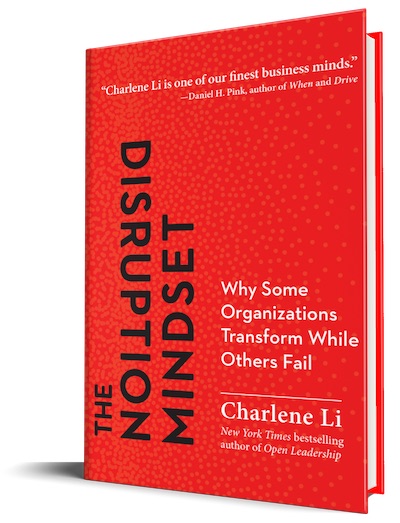Every business leader should read Charlene Li’s “The Disruption Mindset”

I’ve known Charlene Li a very long time. And I’m convinced that her new book, The Disruption Mindset: Why Some Organizations Transform While Others Fail is her finest accomplishment: a fundamentally important and influential strategy book that’s perfectly suited to today’s biggest business challenge.
Disruption is a buzzword. Since Clayton Christensen made it famous with his seminal 1997 book The Innovator’s Dilemma, it has been the watchword for startups everywhere. Uber disrupted the taxi industry. Amazon disrupted the retail industry. Oxo disrupted kitchen implements. It’s a term used so often that it’s become virtually meaningless.
But put aside the hype and you’re left with two questions:
- What is disruption?
- How can big established companies deal with it?
Since Christensen, the received wisdom on question 2 has been “They can’t. Big companies are screwed.”
Charlene’s book is the first realistic response that shows how big companies can deal with disruption.
What causes disruption?
Charlene opens her book with a ringside seat at a failure: she worked for Knight Ridder’s San Jose Mercury News at the start of the the decline of the newspaper business. This is a classic disruption story: a new technology-driven behavior (online news reading) catches a traditional old organization flatfooted. But Knight Ridder didn’t sit idly by. It was in the forefront of embracing online and building out new ways of doing business in the new space. And it still got crushed.
This is the first of many insights in this book:
Like Knight Ridder, many other established companies make disruption their goal and hope that growth will follow. The believe that their innovation will disrupt their market and drive growth. But that’s not how it works: disruption doesn’t create growth; growth creates disruption.
And from this insight emerges the fundamental principles that drives the disruption mindset: a company must concentrate on future customers, even over the needs of current customers.
Like all great insights, this is easy to say, easy to understand, and hellishly hard to do. As Charlene states, “Disruptive transformation is so difficult because it upsets the status quo and shifts power relationships.” You can’t fix it with an “innovation center” because you are attempting to “quarantine fear and disruption” — which makes everyone comfortable, but no one ready for what’s coming. According to The Disruption Mindset, “Innovation is the snooze button of corporate strategy, pushing tough decisions into the future.”
Disruptive transformation is possible
The focus of The Disruption Mindset is not disruption, but disruptive transformation. That is: how can you set up your company (or other large organization) to thrive in a disruptive world?
Despite the conventional wisdom, there are plenty of organizations that have done just that, and Charlene tells their stories.
There’s T-Mobile, which got up off the mat as the fourth-place U.S. mobile carrier and embraced what its future customers wanted — mobile without contracts and bullshit. Result: explosive growth and a transformed, aggressive, highly competitive company.
There’s Adobe, which ditched the packaged software business, where the growth had dissipated, and embraced subscription-based, frequently updated creative software. It took a huge profit hit in the process, but ended up generating growth that would have otherwise been impossible — by embracing the needs of its future customers and their desire for flexible licenses and frequent updates.
There’s Southern New Hampshire University which, facing a financial crisis, elected to become the first accredited, nonprofit online university, upending the very idea of what a college could be and wrapping itself around a customer base that wanted to work on a degree from anywhere.
And there’s Southwest Airlines, consistently profitable for 46 years, and still refusing to charge fees for checked bags.
There’s plenty of realistic advice here, too
Any business book worth reading has to tell you what to do, not just what’s happening. The Disruption Mindset is very strong on that front.
According to Charlene, the three elements of disruptive transformation are:
- A strategy inspired by future customers to make big gulp decisions.
- Leadership that creates a movement of disruptors.
- A culture that thrives with disruption
There are chapters describing how to do each of those. For example, to accomplish the strategy, you need to build the case with rigorous research, secure buy-in with transparency, and burn the boats so that there’s no turning back. At Adobe, for example, that meant testing the subscription model in Australia to get data, constant modeling and explanation to transform everything required to embrace subscription sales and revenues, and a commitment not to update the packaged software, despite the protests of current customers.
The message of this book is not that this is easy. It is the hardest thing your company will ever do. But there are guidelines and research here that prove that you can do it.
And the alternative is to hold tight to your existing business models, products, and customers in the hopes that you can somehow weather the changes without changing your organization. That’s a fantasy, and a dangerous one at that.
Read the book. Then write a review. Then tell your boss. In a world of constant change, it’s the only way to remain viable.
It’ll be fascinating to hear what Charlene says about how news publishers should have dealt with digital disruption, and what they need to do to rise again …